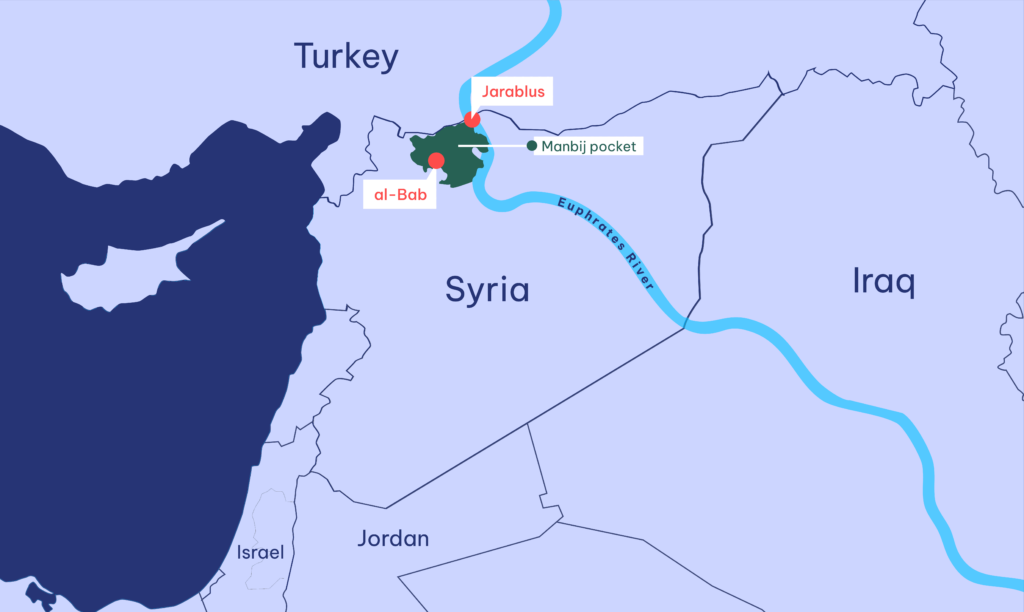Sinan Ciddi has written recently in the Jerusalem Strategic Tribune a multi-part analysis of Turkey in Syria (“Turkey’s Quiet Relationship with ISIS” and previous). His bottom-line argument is that Erdoğan’s Syria policy was driven largely, first, by his desire to spread and eventually lead, political Islam throughout the region, and, second, as a means to that end, to support jihadist groups, the Islamic State (ISIS) in particular.
Ciddi’s facts and to a certain degree his analysis are accurate. This writer can attest to the Islamic or neo-Ottoman nature of Turkish foreign policy thinking from 2008 onward, with Foreign Minister and later Prime Minister Davutoğlu as its public advocate. Further buttressing Ciddi’s argument is the orientation of Prime Minister and later President Erdoğan, by his background in the Millî Görüş Turkish Islamic movement of his mentor Necmettin Erbakan, and by his support for Egyptian President and Muslim Brotherhood leader Muhammad Morsi and Hamas.
But Ciddi leaves unmentioned trends and facts that either refute or significantly modify his arguments. These include growing animosity, then hostility, between ISIS and Turkey, over-identification of Syrian terrorist organization Hayat Tahrir al Sham (HTS) with ISIS and al-Qa’ida, and Erdoğan’s recent good relations with Arab states, in particular the UAE, that are fiercely opposed to Muslim Brother offshoots.
A more serious underlying problem with Ciddi’s analysis is the failure to inventory Turkey’s goals in Syria beyond supporting, deliberately or implicitly, jihadists, a failure seemingly based on an unwillingness to look at a multitude of regional security threats, centered in Syria, through Ankara’s eyes.
This is not an unimportant failure. One state in the region, Israel, largely shares Ciddi’s view. If it is erroneous, however, there is a risk of a Syria-related blowup between the region’s two strongest states.
Coming to the substance of the charges, Ciddi asserts Turkish collaboration with two terrorist groups, ISIS and HTS. The first assertion is overdrawn and the second is correct, although its underlying premise – that such collaboration supported a terrorist agenda – is false.
Turkey, to be sure, allowed many thousands of foreign fighters, many of them Islamists, to transit Turkey to Syrian battlefields during the Syrian civil war. But these were recruits not only for ISIS but also for various forces in the Turkish-supported Free Syrian Army and even groups the US was backing. Trying to sort out which recruit was going to which organization was largely impossible: terrorist organizations did not issue IDs to recruits.The worldview of most of the foreign fighters was generally similar, regardless of group loyalty, and that loyalty often shifted as fighters moved from group to group for various reasons. (The US experienced similar problems with foreign fighters entering Afghanistan in the 1980s.)
Ankara did at times, as Ciddi notes, deal with ISIS. This included negotiating for return of almost 50 Turkish personnel in its Mosul Consulate whom ISIS took hostage, cooperating on the transfer out of the war zone in Syria of the tomb of revered Turkish medieval leader Suleiman Shah, allowing oil exports through middlemen, and coordinating, as in the Adana incident he cites, with ISIS for movement of weapons, money and other supplies.
But even in this early phase up to late 2014 there were a series of clashes between Turks and ISIS, including in Turkey. This animosity grew in late 2014, reaching a crescendo of conflict in the years 2016-17. By 2014, ISIS had lost most of whatever utility it may have had for the Turkish-backed campaign against Asad. ISIS was focusing its attacks more on Iraq and the Kurdish areas of northeastern Syria under the control of the PKK offshoot, YPG, which had stayed neutral thus far in the civil war.
Turkey joined the Defeat-ISIS international coalition in 2014. It allowed Iraqi Kurdish Peshmerga to transit Turkey to support Syrian Kurds defending Kobane against ISIS, and it trained Peshmerga in Iraq fighting ISIS. In 2015, it opened the İncirlik airbase close to the Syrian border to US and other coalition states’ air operations against ISIS, increasing sortie rates. ISIS reacted with a dramatic set of terrorist attacks inside Turkey, killing by 2017 some 300 people.
Then in 2016, Turkey launched a major ground operation against ISIS positions west of the Euphrates River in Operation Euphrates Shield. Turkey’s goals were initially less to fight ISIS than to block the PKK offshoot YPG (by then renamed the “Syrian Democratic Forces”) from extending its control throughout the northwestern Syria border, with the seizure of the Manbij pocket. But the Turkish operation around Jarablus and al-Bab saw major conventional fighting with eventual ISIS defeat and retreat.

Turkish support for HTS was real, but so was US indirect support. HTS was initially in the Syrian civil war an al-Qa’ida offshoot known as Jabhat al-Nusra, listed by the US and UN as a terrorist organization. But under leader Abu Muhammad al-Jolani by 2015 it had renounced its terrorist (if not Islamist) identity, and operating out of its citadel in Idlib province in Syria’s far northwest, proved itself an effective force against Asad, and at times against ISIS. Turkey did not “long mentor” al-Joulani, but maintained a growing, informal liaison with HTS, reportedly through Turkish intelligence, while the US acknowledged the organization’s ideological shift by ruling out striking HTS targets.
HTS and Idlib became critically important in September 2018. While not part of the official Syrian resistance due to its terrorist designation, it was one of the last major forces fighting the Asad-Iran-Russia alliance. Moreover, by that time some 15 percent of Syria’s population, some three million, had fled from Asad to Idlib.
The US received intelligence that the Asad alliance was planning to wipe out the Idlib enclave and HTS. The anticipated results were dire: flight of displaced masses from Idlib to Turkey, overwhelming a country already dealing with three million plus refugees, with many fleeing onward to Europe, likely generating another refugee crisis analogous to that of 2015; and defeat of HTS, spelling military victory for Asad, thereby scotching Washington’s Syria goal, over three administrations, of a ceasefire and compromise resolution of the civil war.
In response President Trump issued a clear public warning to Asad to stand down, and Secretary Pompeo delivered the same message to Russian Foreign Minister Lavrov. The Asad regime then called off the offensive, and in an Istanbul summit in October Putin accepted a ceasefire in Idlib and with Turkish army outposts nearby.
Eighteen months later Asad and allies violated the ceasefire. But both HTS and Turkish forces responded effectively, while the US sent senior officials to the Idlib border and NATO headquarters to underline support for Turkey, HTS, and the millions of displaced caught in the crossfire. Asad consequently called off the offensive, freezing the conflict until his December 2024 overthrow.
The larger point here is that HTS was seen by both Ankara and Washington (somewhat less in the Biden than the first Trump administration) as part of the solution, holding off the Asad alliance while caring for the three million displaced persons in their midst, with much international humanitarian assistance. It was a policy for which Ankara and all others involved should be commended, not condemned.
Turkey has been a largely status quo state since Atatürk, able to defend itself in a tough neighborhood but basing national strength and progress on economic power and diplomatic skill, particularly integrating with the American-led Western order. Such a status does not preclude ambitious adventuresome policies such as Davutoğlu and Erdoğan’s neo-Ottoman approach, just like America’s traditional status quo nature did not preclude George W Bush’s “democratization by the sword” agenda.
Whatever Turkey’s initial goals were for Syria and beyond, by 2015 it was facing multiple threats: Asad allied with an ever more aggressive Iran with thousands of Quds Force and proxy fighters shipped to Syria, a Russian military buildup, a PKK-led “Syrian Democratic Forces with 100,000 fighters, and a potential refugee influx exacerbating the domestic impact of the three million refugees already in Turkey. ISIS, despite its many terrorist attacks, was not of the same order of threat, and Turkey focused its Syria policy on this reality.
If the US expects its partners to ignore what they consider existential threats on their borders in order to prioritize Washington’s threat perspective (which in the case of Syria is constantly changing, from Asad to ISIS to Iran to, under Biden, a confusing mix), then Washington will have few partners.
Perhaps the most concerning aspect of Ciddi’s analysis of Turkish policy towards Syria is the absence of any judgment about the Asad regime, the center of the whole issue. Ciddi is right that Erdoğan sought at various points to overthrow the Asad regime, but he had a lot of company, from the Obama administration to leading Gulf states and, implicitly, the Arab League in suspending Syria’s membership.
And for good reason. That regime’s murderous assault on its own people produced over 600,000 deaths and 12 million citizens fleeing the regime, half the population, not to speak of the Syrian civil war’s myriad threats to all its neighbors and regional stability as a whole, especially given Asad’s link to Iran.
What does Ciddi think of all this? Is it a good thing that Asad fell and Iran lost much of its “Shia crescent” — a development unlikely without Turkish pressure and support for HTS? Is some accretion of Turkish regional power and influence, and an HTS-led government in Damascus, too high a price to applaud the fall of Asad and collapse of most of the Iranian proxy network?

